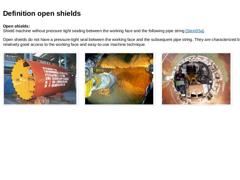
|

Open shields:
Shield machine without pressure tight sealing between the working face and the following pipe string [Stein05a]. Open shields do not have a pressure-tight seal between the working face and the subsequent pipe string. They are characterized by relatively good access to the working face and easy-to-use machine technique. (Image: Hand shields - Overall view of a hand shield (external diameter 2098 mm) [FI-Nishi]) (Image: Open shield) (Image: … |
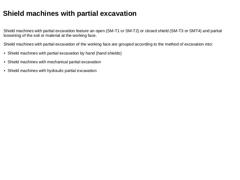
|

|
Shield machines with partial excavation feature an open (SM-T1 or SM-T2) or closed shield (SM-T3 or SMT4) and partial loosening of the soil or material at the working face.
Shield machines with partial excavation of the working face are grouped according to the method of excavation into: -
Shield machines with partial excavation by hand (hand shields)
-
Shield machines with mechanical partial excavation
-
Shield machines with hydraulic partial excavation
|
|
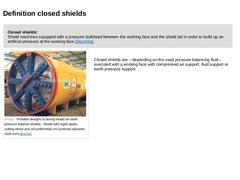
|
|
Closed shields:
Shield machines equipped with a pressure bulkhead between the working face and the shield tail in order to build up an artificial pressure at the working face [Stein05a]. |
(Image: Possible designs of boring heads for earth pressure balance shields - Shield with eight-spoke cutting wheel and circumferential rim (external diameter 3100 mm) [Breme])
Closed shields are – depending on the used pressure balancing fluid – executed with … |
|
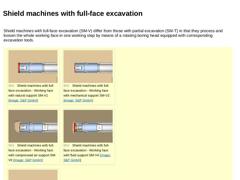
|

| Shield machines with full-face excavation (SM-V) differ from those with partial excavation (SM-T) in that they process and loosen the whole working face in one working step by means of a rotating boring head equipped with corresponding excavation tools. | | (Image: Shield machines with full-face excavation - Working face with natural support SM-V1) | (Image: Shield machines with full-face excavation - Working face with mechanical support SM-V2) | | (Image: … |
|
|
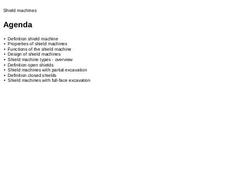
|

|
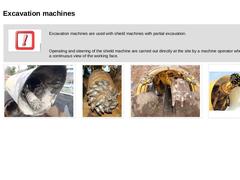
|
|
(Image: Attention!)
Excavation machines are used with shield machines with partial excavation.
Operating and steering of the shield machine are carried out directly at the site by a machine operator who has a continuous view of the working face. |
|
(Image: Shield machine with fixed installed boom cutting machine - With axial cutting head) |
(Image: Axial cutter head of the boom cutting machine equipped with round shank cutter bits) |
(Image: Principles … |
|
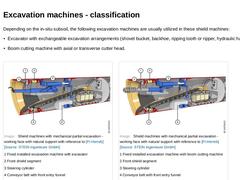
|

Depending on the in-situ subsoil, the following excavation machines are usually utilized in these shield machines: -
Excavator with exchangeable excavation arrangements (shovel bucket, backhoe, ripping tooth or ripper, hydraulic hammer)
-
Boom cutting machine with axial or transverse cutter head.
(Image: Shield machines with mechanical partial excavation - working face with natural support with reference to [FI-Herreb] [Image: S&P GmbH]) (Image: Shield … |
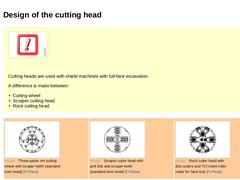
|
|
(Image: Attention!)
Cutting heads are used with shield machines with full-face excavation.
A difference is made between: -
Cutting wheel
-
Scraper cutting head
-
Rock cutting head
|
|
|
|
(Image: Three-spoke rim cutting wheel with scraper teeth (standard bore head) [FI-Rasa]) |
(Image: Scraper cutting head with pick bits and scraper teeth (standard bore head) [FI-Rasa]) |
(Image: Rock cutting head with disc cutters and TCI insert roller cutter for hard … |
|
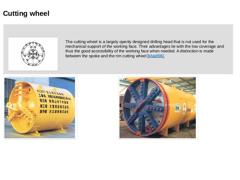
|

|
(Image: Three-spoke rim cutting wheel with scraper teeth (standard bore head) [FI-Rasa]) The cutting wheel is a largely openly designed drilling head that is not used for the mechanical support of the working face. Their advantages lie with the low coverage and thus the good accessibility of the working face when needed. A distinction is made between the spoke and the rim cutting wheel [Maidl98]. |
|
(Image: Possible designs of boring heads for earth … |
|
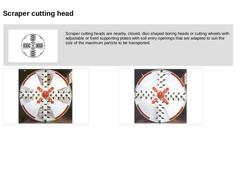
|
|
(Image: Scraper cutting head with pick bits and scraper teeth (standard bore head) [FI-Rasa])
Scraper cutting heads are nearby, closed, disc-shaped boring heads or cutting wheels with adjustable or fixed supporting plates with soil entry openings that are adapted to suit the size of the maximum particle to be transported. |
|
(Image: Open shield machine with scraper cutting head and mechanical support of the working face - Variably adjustable soil … |
|
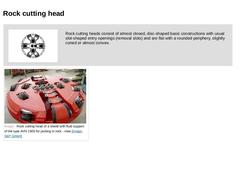
|
|
(Image: Rock cutting head with disc cutters and TCI insert roller cutter for hard rock [FI-Rasa])
Rock cutting heads consist of almost closed, disc-shaped basic constructions with usual slot-shaped entry openings (removal slots) and are flat with a rounded periphery, slightly coned or almost convex. |
|
(Image: Rock cutting head of a shield with fluid support of the type AVN 1500 for jacking in rock - view) |
|
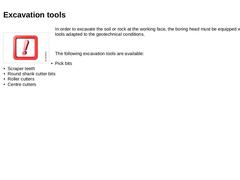
|

(Image: Attention!) In order to excavate the soil or rock at the working face, the boring head must be equipped with excavation tools adapted to the geotechnical conditions. The following excavation tools are available: -
Pick bits
-
Scraper teeth
-
Round shank cutter bits
-
Roller cutters
-
Centre cutters
|
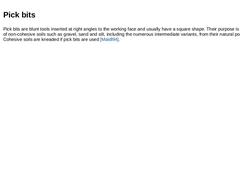
|

Pick bits are blunt tools inserted at right angles to the working face and usually have a square shape. Their purpose is the loosening of non-cohesive soils such as gravel, sand and silt, including the numerous intermediate variants, from their natural positions. Cohesive soils are kneaded if pick bits are used [Maidl94]. |
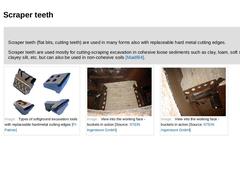
|
Scraper teeth (flat bits, cutting teeth) are used in many forms also with replaceable hard metal cutting edges. Scraper teeth are used mostly for cutting-scraping excavation in cohesive loose sediments such as clay, loam, soft slate, clayey silt, etc. but can also be used in non-cohesive soils [Maidl94]. |
|
(Image: Types of scraper teeth with replaceable hardmetal cutting edges [FI-Palmie]) (Image: View into the working face - Scraper teeth in action) (… |
|
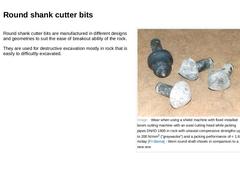
|

Round shank cutter bits are manufactured in different designs and geometries to suit the ease of breakout ability of the rock. They are used for destructive excavation mostly in rock that is easily to difficultly excavated. (Image: Wear when using a shield machine with fixed installed boom cutting machine with an axial cutting head while jacking pipes DN/ID 1600 in rock with uniaxial compressive strengths up to 200 N/mm2 ("greywacke") and a jacking … |
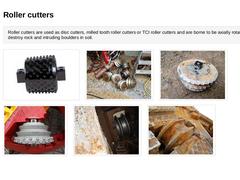
|
Roller cutters are used as disc cutters, milled tooth roller cutters or TCI roller cutters and are borne to be axially rotatable. They destroy rock and intruding boulders in soil. (Image: Types of roller cutters [FI-Palmie] - (Tungsten carbide) Insert roller cutter) (Image: Types of roller cutters - Triple disc cutters) (Image: Types of roller cutters - Triple disc cutters) (Image: Types of roller cutters - Triple disc cutters) (Image: Installed roller … |
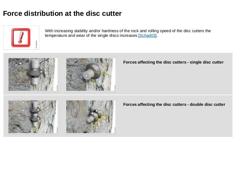
|

|
(Image: Attention!)
With increasing stability and/or hardness of the rock and rolling speed of the disc cutters the temperature and wear of the single discs increases [Schad03]. |
|
(Image: Forces affecting the disc cutters ? single disc cutter with reference to [Schad03] [Image: S&P GmbH]) |
(Image: Forces affecting the disc cutters ? single disc cutter with reference to [Schad03] [Image: S&P GmbH]) |
Forces affecting the disc cutters - single disc … |
|

|

Centre cutters are excavation tools arranged in advance in the centre of the boring head in order to release the pressure in the centre of the working face during boring and especially in cohesive soils such as clay and silt with low to high plastic properties to counteract sticking of the boring head. |
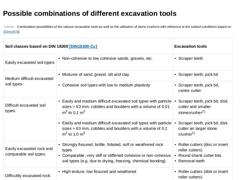
|

|
(Table: Combination possibilities of the various excavation tools as well as the utilization of stone crushers with reference to the subsoil conditions) |
|
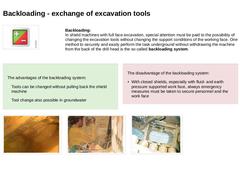
|
Backloading:
In shield machines with full face excavation, special attention must be paid to the possibility of changing the excavation tools without changing the support conditions of the working face. One method to securely and easily perform the task underground without withdrawing the machine from the back of the drill head is the so-called backloading system. The advantages of the backloading system: |
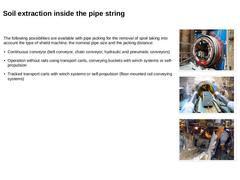
|
The following possibilities are available with pipe jacking for the removal of spoil taking into account the type of shield machine, the nominal pipe size and the jacking distance: -
Continuous conveyor (belt conveyor, chain conveyor, hydraulic and pneumatic conveyors)
-
Operation without rails using transport carts, conveying buckets with winch systems or self-propulsion
-
Tracked transport carts with winch systems or self-propulsion (floor-mounted …
|
|
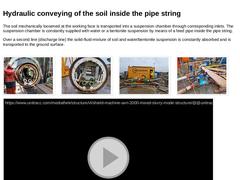
|
The soil mechanically loosened at the working face is transported into a suspension chamber through corresponding inlets. The suspension chamber is constantly supplied with water or a bentonite suspension by means of a feed pipe inside the pipe string. Over a second line (discharge line) the solid-fluid-mixture of soil and water/bentonite suspension is constantly absorbed and is transported to the ground surface. (Image: Hydraulic soil conveying) (… |
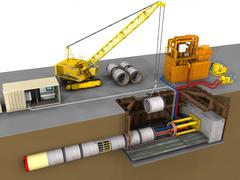
|
Today, the installation of gas, water and wastewater pipelines is still predominantly carried out using open trenches. In view of the numerous disadvantages associated with this method, it is imperative that trenchless pipeline construction be considered much more strongly in the future than it has been to date as an alternative in the planning and construction of sewers and pipelines. This module deals in detail with the procedure and the various components. Emphasis is placed on the different types of shield machines, excavation tools, separation systems, the control and steering station, injection/grouting agent and soil extraction and reprocessing. After completing this module, you will have a sound knowledge of: - all components of pipe jacking and
- their function and tasks.
|
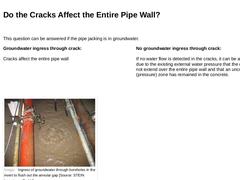
|

|
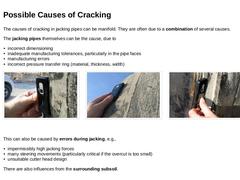
|

|